Abstract
Hybrid nano-materials offer potential scope for an increasing numerous novel applications when engineered to deliver availably functional properties. In the present study, the SiO2/MoS2 hybrid nanoparticles with different mass ratios were employed as lubricant additives in the base oil, and their tribological properties were evaluated using a reciprocating ball-on-plate tribometer for magnesium alloy-steel contacts. The results demonstrate that the SiO2/MoS2 hybrid nanoparticles exhibit superior lubrication performances than individual nano-SiO2 or nano-MoS2 even in high load and diverse velocity cases. The optimal SiO2/MoS2 mixing ratio and the concentration of SiO2/MoS2 hybrid nanoparticles in the base oil are 0.25:0.75 and 1.00–1.25 wt%, respectively. The excellent lubrication properties of the SiO2/MoS2 hybrid nanoparticles are attributed to the physical synergistic lubricating actions of nano-SiO2 and nano-MoS2 during the rubbing process.
Keywords: SiO2/MoS2 hybrid nanoparticles, Lubricant additive, Magnesium alloy, Friction and wear
Background
Magnesium and its alloys are promising materials in transportation, electronics industries, or aerospace for their excellent properties, such as low density, high specific strength, and electromagnetic compatibility [1, 2]. Nowadays, magnesium alloy products are mainly fabricated by casting and die-casting [3]. However, the poor mechanical properties of the cast alloys are not sufficient to meet the demand of most load-bearing structural components. Compared with casting products, wrought magnesium alloys fabricated by plastic deformation processes, such as rolling, extrusion, and forging, seem to be more attractive owing to their competitive productivity and performance [4]. It should be noted that the tribological interaction always takes place during forming process as two contact surfaces (tool steel and the metal) move relative to each other. These create a great challenge to achieve high-quality product and extended tool life [5].
The use of liquid lubricants to decrease friction is an efficient way to improve energy efficiency and mechanical durability, especially in the case of magnesium and its alloys. Unfortunately, so far, there are no suitable forming fluids for the forming process of Mg alloy, even at some conditions, the forming fluid used for Al alloy forming is casually used and the result is not satisfied. The application of conventional oil-based lubricant in Al alloy forming processes relies heavily on sulfur-, chlorine-, and phosphorous-containing additives. These additives form easily sheared tribo-layers on metal surfaces, thus controlling friction and reducing wear [6]. However, the fast chemical degradation of these additives during application is accompanied by a loss of their lubrication performances. Even worse, the abovementioned additives cause negative effects on the environment even at low concentrations during the disposal of waste fluids [7]. Therefore, the exploration of the harmless lubricant with the excellent tribological performances still continues. Some efforts have already been made in order to find novel lubricant additives for magnesium alloy, such as N-containing compounds [8], borates [9], and ionic liquids [10]. All of them as lubricant additives are capable of forming tribo-layers with low shear strength to protect the contacting surfaces from damage, thereby improving the lubrication performances. Nonetheless, some problems are associated with their applications. For instance, many amide-based friction reducing agents for lubricating oils, including straight-chain amides, are not liquid at low temperature [11]. The borate without active elements, i.e., nitrogen, sulfur and chlorine, cannot be used as good lubricant additive for magnesium alloy. Additionally, boron is an electron-deficient element and has a great affinity with oxygen borate esters susceptible to hydrolysis in the presence of moisture [12]. The high cost and tedious procedure for the preparation of ionic liquids are main problems to put them into industrial application after 10 years of extensive development [13]. These disadvantages are key problems to replace the traditional phosphors- and chlorine-containing additives with the aforementioned additives.
Over the past few years, the addition of nanoparticles as lubricant additives into base fluids is a rapidly progressing field of research because nanoparticles are different from traditional bulk materials due to their extremely small size, high specific surface area, and variety of particle chemistries [14, 15]. Meanwhile, due to the tiny usage of nanoparticle additive, the negative influence on the environment is greatly suppressed [16–18]. Among of the nanoparticles, the layered nanomaterials with different shapes and morphologies, such as MoS2 nanoparticles, are widely used as additives to liquid lubricants [19]. Previous studies have shown that MoS2 nanoparticles can effectively reduce the friction in the boundary lubrication for steel/steel contacts and titanium alloy/steel pairs based on the formation of diverse types of tribo-film [20, 21]. Moreover, it was also reported that MoS2 nanoparticles can decrease the friction and wear even on relatively inert surfaces, such as diamond-like carbon (DLC) film [22, 23]. Despite many attempts, the combination of nano-MoS2 with other nanoparticles or compounds is of particular significance in terms of their application as lubricant additives because the combinations usually exhibit more prominent lubrication performances in contrast with individual nanoparticles attributed to the synergistic effect among two or more components. In this respect, Kunhong Hu et al. [24] synthesized TiO2/MoS2 nano-clusters and the tribological properties of the as-prepared TiO2/MoS2 nano-clusters as lubricant additive were investigated using a four-ball tribometer. It was found that the MoS2/TiO2 (2:1) nano-clusters achieve the lowest friction coefficient (μ = 0.045), which is 30.8 and 40 % lower than pure MoS2 and pure TiO2, respectively. Yanbin Zhang et al. [25] reported the use of carbon nanotubes (CNT)/MoS2 hybrid nanoparticles in minimum quantity lubrication for Ni-based alloy grinding. The results demonstrated that lower grinding forces and better ground surface were achieved by CNT/MoS2 hybrid nanofluids. Moreover, the optimal MoS2/CNT mixing ratio and nanofluid concentration are 2:1 and 6 wt%, respectively. Yufu Xu et al. [26] investigated the tribological behaviors of esterified bio-oil (EBO) and EBO containing graphene or/and MoS2 for steel/steel pairs by a point contact undirectional sliding tribometer. A synergistic effect on friction reduction and wear protection was observed with the graphene/MoS2 hybrids when added into EBO. These researches primarily demonstrate that MoS2-based hybrid nanoparticles have great potential as lubricant additives and are worth carrying out further study. As compared with the aforementioned nanoparticles, the SiO2 nanoparticles have attracted a great deal of research attention as a lubricant additive owing to excellent tribological performances, low cost, and facile preparation. Previous investigations about the lubrication properties of SiO2 nanoparticles mainly focused on Al alloy forming process, such as Al alloy machining and drilling [27, 28]. Experimental results showed that SiO2 nanofluids cause a decrease in friction coefficient and increase in surface quality of workpiece during machining process. This effect has been attributed to the rolling action of nanoparticles between the contact surfaces. In our early work, the tribological behaviors of nano-SiO2 and nano-MoS2 as lubricant additives for magnesium alloy/steel pairs have been studied and found that nano-MoS2 achieves better anti-wear behavior than nano-SiO2, while nano-SiO2 possesses better friction reducing behavior than nano-MoS2 [29]. In view of their respective special tribological characteristics, it is worth to study how the two particles behave together as lubricant additive and try to further optimize the comprehensive tribological performances.
The aim of the current study is to provide an effective SiO2/MoS2 hybrid nanoparticles additive for the development of magnesium alloys forming fluid. The tribological behaviors of the SiO2/MoS2 hybrid nanoparticles were investigated by considering the friction coefficient and wear volume. Further, the lubrication mechanism was discussed in detail.
Methods
Materials
EOT5# engine oil (5.11 mm2/s at 40 °C and 0.856 g/cm3 at 15 °C) was adopted as base oil in the tribological investigation because it is typical oil for nonferrous metal cold forming applications. According to the supplier (Hasitai Lubricant Co., Ltd Shanghai, China), the EOT5# lubricant oil is free from sulfur, phosphorus, chlorine, and other additives. The authors deliberately chose to use a lubrication of free additives as base oil, so as to isolate the effects of the nanoparticles additives. Moreover, the use of sulfur-, chlorine-, and phosphorus-containing compounds should be restricted for environmental reasons. The nano-MoS2 and nano-SiO2 used in this study were procured commercially from Nanjing Emperor Nano Material Co. Ltd, Nanjing, China. The morphology of the two samples was investigated with Zeiss AURIGA field emission scanning electron microscope (FESEM) and JEM 1200EX transmission electron microscopy (TEM) as shown in Fig. 1. It can be observed that the nano-MoS2 possesses a flake-like shape mainly with above 300 nm in length and about 90 nm in thickness, and the nano-SiO2 keeps a spherical micro-structure with a mean diameter of 30 nm. The nanofluids were prepared as follows: nano-SiO2, nano-MoS2 and their hybrids, with different concentrations (mass fraction) of nano-SiO2 and nano-MoS2, were separately dispersed into the base oil through ultrasonication for 2 h to obtain a series of homogeneous suspensions.
Fig. 1.
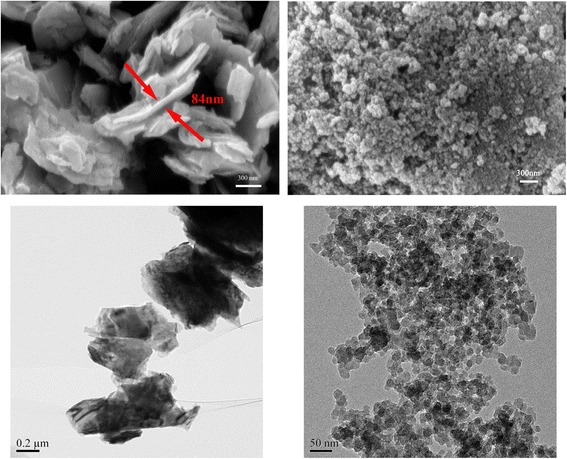
FESEM and TEM images of nano-MoS2 (left) and nano-SiO2 (right)
Friction and Wear Test
The friction reduction and anti-wear abilities of nanofluids were evaluated using a reciprocating ball-on-plate friction and wear tester (CSM Instruments, Peseux, Switzerland). Throughout the test, the upper AISI 52100 steel ball with diameter of 6 mm and surface roughness (Ra) of 0.05 μm slides against the lower fixed AZ31 magnesium alloy plates. The starting billet of commercial as-cast AZ31 magnesium alloy (Mg-3.07Al-0.78Zn-0.38Mn in wt%) with 82 mm in diameter was homogenized at 380 °C for 2 h. Subsequently, this ingot was extruded to the sheet of 3-mm thickness (normal direction, ND) and 56-mm width (transverse direction (TD)) at 380 °C. Meanwhile, the speed of extrusion process was 20 mm/s with the extrusion ratio of 34:1. The mechanical properties of the extruded AZ31 Mg alloy are provided in Table 1.
Table 1.
Mechanical properties of extruded AZ31 magnesium alloy used in this study
| Material | 0.2 % YS/MPa | UTS/MPa | Elongation/% | HV0.01 |
|---|---|---|---|---|
| Extruded AZ31 | 142.1 | 305 | 18.5 | 66.7 |
The as-extruded sheet was cut into samples with dimensions of 10 mm (TD) × 20 mm (ED) × 3 mm (ND). Prior to examination, the samples were polished with 1000 grit silicon carbide paper to a mean surface roughness of Ra ~0.08 μm. The ball slides at a stroke of 6 mm back and forth along extrusion direction. In the first group of experiments, the influence of the SiO2/MoS2 mixing ratio on the lubrication behaviors of nanofluids was discussed. The normal load during the tribological tests was 8 N corresponding to maximum Hertzian contact stress 446 MPa of at least 50 % higher than the yield strength of magnesium alloy sheets. The sliding speed was 30 mm/s, and the sliding test duration was 1.5 h. Lubricant oil was supplied to the top of the plate before testing, covering the entire surface. Friction coefficient and wear volume were used as characterization parameters. Five different SiO2/MoS2 mixing ratios were designed: pure MoS2, SiO2/MoS2 (0.25:0.75), SiO2/MoS2 (0.5:0.5), SiO2/MoS2 (0.75:0.25), and pure SiO2. The concentration of these additives in the base oil was 1 wt%. The optimal SiO2/MoS2 mixing ratio was obtained from the first group of experiments. However, the concentration of nanoparticles in the base fluids is another fundamental issue because excessive concentration will make nanoparticles agglomeration and thereby destroy lubrication properties. In the second group of experiments, the influence of the concentration of SiO2/MoS2 hybrid nanoparticles on lubrication properties was discussed by changing the mass fraction of the SiO2/MoS2 hybrid nanoparticles in the base oil. The nanofluids were prepared as 0.25, 0.50, 0.75, 1.00, 1.25, 1.50, and 2.00 % by weight of SiO2/MoS2 hybrid nanoparticles into the base oil. The optimal concentration was determined. In the third group of experiments, the influence of normal load and sliding speed on the lubrication properties of the fluids was performed with a normal load varying from 1 to 10 N (corresponding maximum Hertzian contact stress from 223 to 480 MPa) and a sliding velocity ranging from 10 to 80 mm/s for 30 min. The friction coefficient was recorded by the tribometer in real time. Three sets of tests at the same normal pressure and sliding velocity were conducted to obtain each datum point to verify the repeatability and accuracy of the test results. Using nanofluids, the wear of the AISI 52100 steel ball was not measurable and there was almost no variation in the roughness measurements. For this reason, the wear volume of AZ31 magnesium alloy plate was calculated to evaluate the lubricant effectiveness in wear reduction in the overall lubricating system.
Characterization
The morphologies of the worn surfaces were determined by Zeiss AURIGA FESEM. The wear depth and wear track profiles after the friction tests were obtained by a noncontact 3D surface profiler (Olympus OLS4000), and the wear volume of the plates was calculated from the wear depth. The final values quoted for the wear volume of the specimen were averages of three tests results. The chemical compositions of the worn surfaces were characterized by a VG model Escalab 250 X-ray photoelectron spectroscopy (XPS) with Al-Kα radiation as the excitation source. And the binding energy of C1s at 284.6 eV was utilized as the reference. Prior to the analysis, the specimens were cleaned ultrasonically for 5 min with acetone, in order to eliminate the residual lubricant.
Results and Discussion
Effect of SiO2/MoS2 Mixing Ratio on Lubrication Performance
Figures 2 and 3 display the friction and wear results of the SiO2/MoS2 hybrid nanofluids for magnesium alloy/steel contacts at 8 N and 30 mm/s for 1.5 h, compared with those of pure nanofluids and neat oil without nanoparticles tested in the same conditions. Among the six prepared fluids, the base oil gives the highest friction coefficient (μ = 0.103). The changes in sliding time have significant effect on the friction coefficient of the base oil. It can be seen that the friction coefficient of the base oil shows considerable oscillation during the test. The friction coefficient of pure MoS2 nanofluids and pure SiO2 nanofluids are 0.085 and 0.078, respectively. It is evident from these measurements that pure nanoparticles as lubricant additive have positive functions for improving the friction reduction performance of the base oil. As the increase of test duration, the friction coefficient of pure SiO2 nanofluids varies in the range of 0.07–0.09, accompanied by severe oscillation. While for the pure MoS2 nanofluids, the friction coefficient decreases from an initial value of ∼0.11 to ∼0.08 after rubbing for 1000 seconds and remained essentially constant thereafter. This result proves that the pure MoS2 nanofluids have much better friction reduction properties than pure SiO2 nanofluids at a longer test time. However, the reduction of friction coefficient is more significant for the three SiO2/MoS2 hybrid nanofluids when compared to that found with the pure nanofluids. The improvement of lubrication performances should be ascribed to the synergistic lubricating effect of the hybrid nanoparticles during sliding. The friction coefficient of the SiO2/MoS2 hybrid nanofluids decreases with increasing mixing ratio of SiO2 to MoS2 until a mass ratio of 0.25:0.75 (SiO2/MoS2) is achieved. With the further increase of mixing ratio of SiO2 to MoS2, the friction coefficient gradually increases. The SiO2/MoS2 (0.25:0.75) hybrids achieve the lowest friction coefficient (μ = 0.055), which is 35.3 and 29.5 % lower compared with pure MoS2 and pure SiO2, respectively. In addition, the friction coefficient of the SiO2/MoS2 (0.25:0.75) hybrid nanofluids shows a slightly fluctuation at the initial stage of the test and then decreases and stabilizes gradually in the latter part of the curve. The excellent lubricating performances of SiO2/MoS2 (0.25:0.75) hybrid nanofluids indicate that the synergistic lubricating effect of nano-SiO2 and nano-MoS2 are closely related to the mixing ratio of SiO2 to MoS2 in the base oil.
Fig. 2.
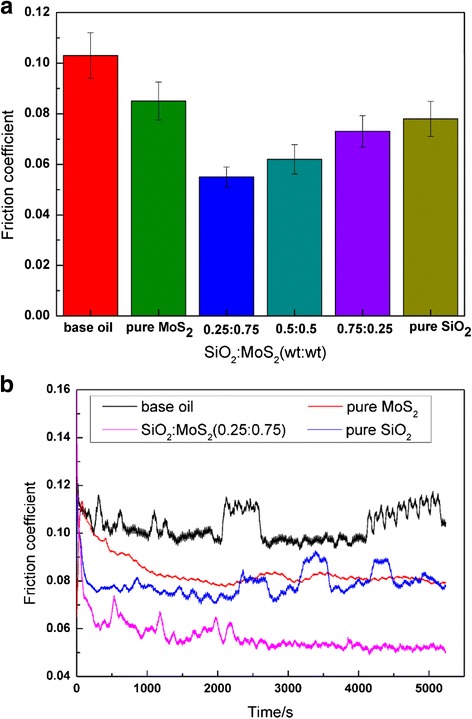
a Changes in the average friction coefficient as a function of different SiO2/MoS2 mixing ratios. b Evolution of the friction coefficient with the sliding time (8 N, 30 mm/s, 1.5 h)
Fig. 3.
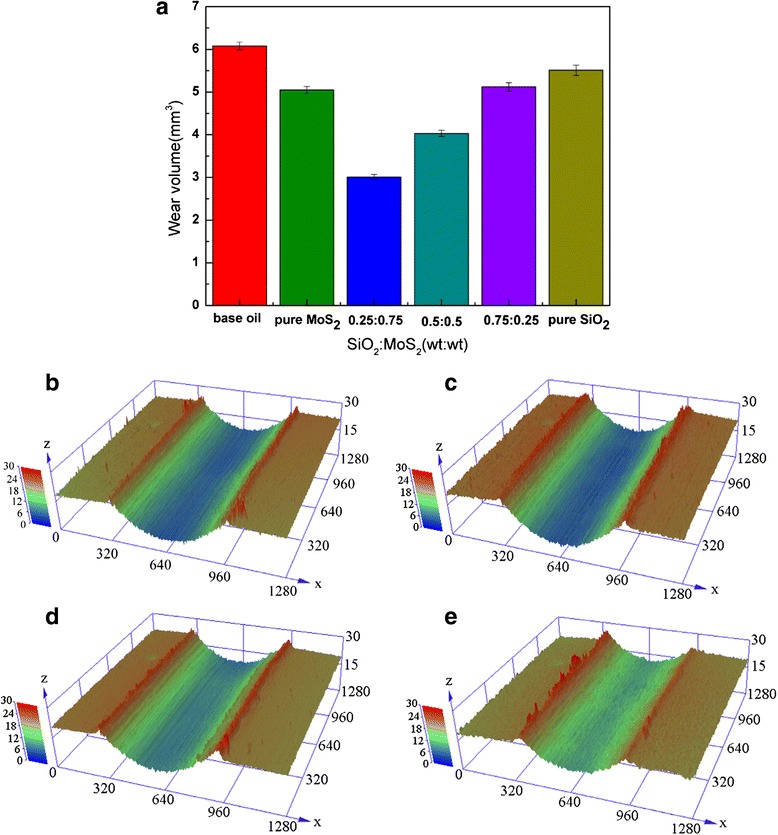
a Changes in the average wear volume as a function of different SiO2/MoS2 mixing ratios and 3D optical microscopic images of the wear tracks corresponding to b base oil, c pure SiO2, d pure MoS2, and e SiO2/MoS2 (0.25:0.75) (8 N, 30 mm/s, 1.5 h)
Figure 3 shows average wear volume and 3D optical microscopic images of the wear tracks lubricated with different samples. The variation of wear volume is similar to the change in friction coefficient in Fig. 2. In this respect, the SiO2/MoS2 (0.25:0.75) hybrid nanofluids also outperform the rest samples. In comparison with the base oil, the SiO2/MoS2 (0.25:0.75) hybrid nanofluids lead to a significant reduction of wear volume by 50.5 % (from 6.08 to 3.01 mm3 in mean value). In contrast, the pure MoS2 nanofluids and SiO2 nanofluids are less effective by offering 17 and 9.4 % wear volume reduction in contrast with the base oil (from 6.08 to 5.05 and 5.51 mm3 in mean value), respectively. Comparative results of friction coefficient and wear volume under different SiO2/MoS2 mass ratio further prove the lubrication advantages of the SiO2/MoS2 (0.25:0.75) hybrid nanofluids.
Effect of the Concentration of Hybrid Nanoparticles on the Lubrication performance
It can be concluded from the previous experiments that 0.25:0.75 is the optimal SiO2/MoS2 mixing ratio of hybrid nanoparticles. In this group of experiments, the effect of the SiO2/MoS2 (0.25:0.75) hybrid nanoparticles concentration on the lubrication properties was investigated by changing the mass fraction (from 0.25 to 2 wt%) of the SiO2/MoS2 hybrid nanoparticles in the base oil. Figure 4 shows variations in the friction coefficient and wear volume with concentration of the SiO2/MoS2 (0.25:0.75) hybrid nanoparticles in the base oil at 8 N and 30 mm/s for 1.5 h. It can be observed that both friction coefficient and wear volume illustrate a nearly similar pattern with increasing concentration of the SiO2/MoS2 hybrid nanoparticles in the base oil. Both friction coefficient and wear volume decrease initially and then increase with increasing concentration of the SiO2/MoS2 hybrid nanoparticles. The lowest friction coefficient emerges at the concentration of 1.25 wt%, and the smallest wear volume appears at the concentration of 1.00 wt%. Therefore, the optimal concentration of SiO2/MoS2 hybrid nanoparticles in the base oil is 1.00–1.25 wt%. Nanoparticle agglomeration occurs once this optimum concentration is exceeded, which will influence the lubrication efficacy [30]. On the one hand, nanoparticle agglomeration destroys the integrity of the lubrication film. On the other hand, it is also considered that the increased number of nanoparticles clusters sliding against each other can have increasing influence on friction coefficient and wear volume [31]. Based on the observations on the tribological behaviors of the SiO2/MoS2 hybrid nanofluids and cost savings, 1.00 wt%, concentration of the SiO2/MoS2 hybrid nanoparticles in the base oil was chosen for further testing.
Fig. 4.
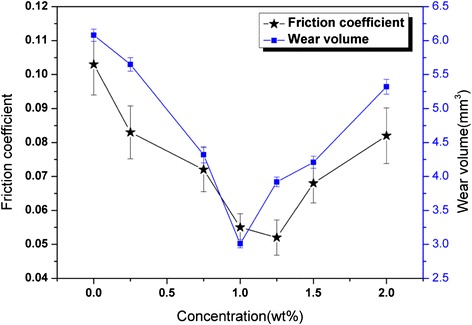
Variations of the friction coefficients and wear volume of the plates lubricated with the SiO2/MoS2 (0.25:0.75) hybrid nanofluids as a function of SiO2/MoS2 (0.25:0.75) hybrid nanoparticles concentration (8 N, 30 mm/s, 1.5 h)
Effect of Normal Load and Sliding Speed on Lubrication Performance
The effect of the normal load (from 1 to 10 N) on the lubrication properties of the 1.00 wt% SiO2/MoS2 (0.25:0.75) hybrid nanofluids was studied for magnesium alloy/steel contacts at 80 mm/s for 30 min, compared with those of pure nanofluids and neat oil without nanoparticles tested in the same conditions. The mean friction coefficient and wear volume are reported in Fig. 5. It can be observed that the average friction coefficient for base oil and pure SiO2 nanofluids increases gradually with the increase of load. Higher loads can lead to smaller micro-intervals between the friction pairs. There is less base oil at a molecular level that could be drawn into the frictional interface, thus increasing friction coefficient [32]. In case of pure SiO2 nanofluids, spherical SiO2 nanoparticles are more likely to roll between the rubbing surfaces, thus reducing the friction coefficient [33]. However, it is necessary to emphasize that the rolling effect of spherical nanoparticles during rubbing is closely related to the thickness of the lubricant film. It has been reported in the literature [34] that when the thickness of the lubricant film is close to the size of the spherical nanoparticles, the shape of the nanoparticles is preserved. In our study, the corresponding minimum film thickness between two surfaces can be approximately predicted by the Hamrock-Dowson equation [35]. The thickness of lubricant film at the point of contact is 44, 35, 31, 28, and 26 nm for 1, 3, 5, 8, and 10 N, respectively. This would indicate that the thickness of the lubricant film between the friction pairs decreases with the increase of the load and is getting close to the size of the spherical SiO2 nanoparticles. The shape of the nanoparticles is preserved during sliding, thereby increasing friction coefficient. The friction behaviors of the pure MoS2 nanofluids and the SiO2/MoS2 hybrid nanofluids are found to be quite different from the base oil and pure SiO2 nanofluids under the same test conditions. After the nano-MoS2 or SiO2/MoS2 hybrid nanoparticles are added into the base oil, the average friction coefficient decreases gradually with load increasing. During sliding process, part of nano-MoS2 diffused into the friction region and took tribo-chemistry reaction with rubbing surface to generate a tribo-chemical reaction films which can protect magnesium alloy surface effectively. The forming velocity of tribo-chemical reaction film is closely related to the energy supplied during the rubbing process. With the load increasing, more energy will be provided and the nano-MoS2 becomes easier to react with the new-exposed friction pair surfaces. This contributes to the formation of the tribo-chemical reaction film on the surface, and thus resulting in friction reduction [36]. However, the wear volume of all samples maintains a similar trend, increasing gradually with the increase in normal load. At lower loads, the anti-wear behavior is marginally different with all the nanofluids reporting similar wear volume. However, with the increased load the difference in the anti-wear behavior is substantial. Moreover, the wear volume of the SiO2/MoS2 hybrid nanofluids is significantly lower than that of the rest samples at high load. The different friction coefficient and wear volume can be attributed to the formation of disparate adsorption film and/or tribo-chemical reaction film on the rubbing metal surface. Detailed information on the composition of the films formed on the rubbing surfaces is presented in the “Rubbing Surface Analyses section.”
Fig. 5.
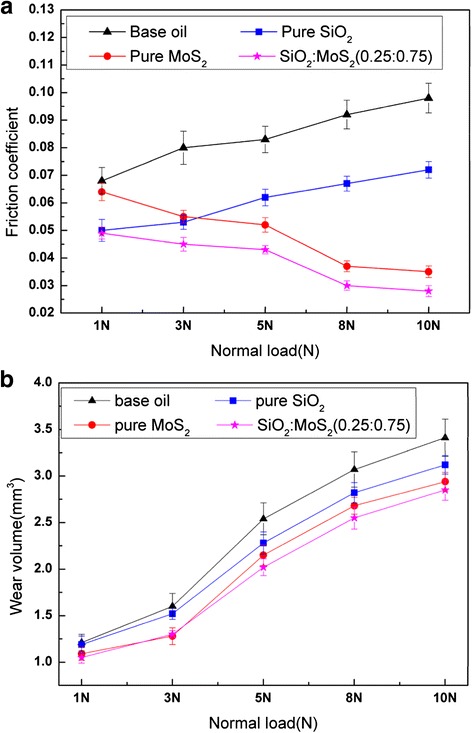
Effects of loads on a average friction coefficient and b wear volume of magnesium alloy specimens lubricated by the base oil with and without additives (sliding speed 80 mm/s; testing time 0.5 h)
During the tests, the sliding speed can make another significant impact on the lubrication performances. Figure 6 describes the variations of the friction coefficients and wear volumes of the plates lubricated with the SiO2/MoS2 hybrid nanofluids as a function of the sliding speed, compared with those of pure nanofluids and neat oil without nanoparticles tested in the same conditions. It can be observed that the friction coefficients of all the fluids gradually decreased with an increase in the sliding velocity over a wide range of 10 to 80 mm/s at 5 N for 30 min. With an increase in the sliding speed, a thicker liquid layer would be formed between the shearing surfaces, thus reducing the actual contact area and the friction force. From Fig. 6b, it can be seen that the wear of magnesium alloy specimens increased with the increase in sliding speed when lubricated by all the fluids. This can be explained by the fact that there is a longer sliding distance within the same test duration at higher sliding speeds. The most significant improvement of lubricity is obtained by the SiO2/MoS2 hybrid nanofluids for the entire range of sliding velocities. The lubricating mechanism for the SiO2/MoS2 hybrid nanofluids is further analyzed in the “Lubrication Mechanism of the SiO2/MoS2 Hybrid Nanofluids” section.
Fig. 6.
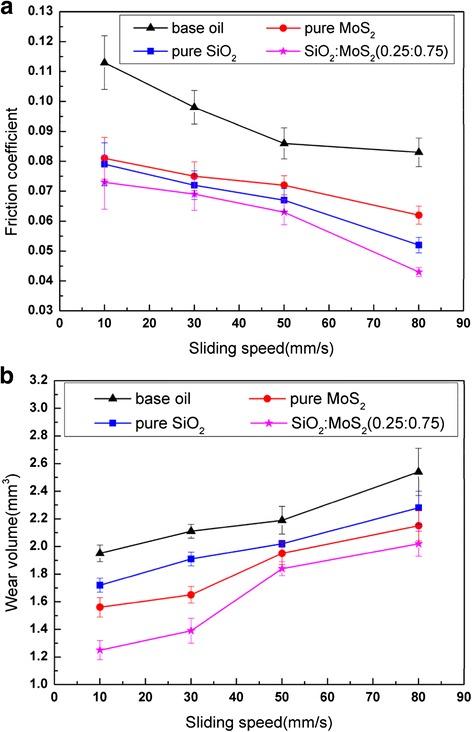
Effects of sliding speeds on a average friction coefficient and b wear volume of magnesium alloy specimens lubricated by the base oil with and without additives (normal load 5 N; testing time 0.5 h)
Rubbing Surface Analyses
Figure 7 displays the FESEM morphologies of the worn surfaces of the magnesium alloy lubricated with base oil, pure MoS2 nanofluids, pure SiO2 nanofluids, and SiO2/MoS2 (0.25:0.75) hybrid nanofluids under the load of 8 N and the speed of 30 mm/s for 1.5 h. It is clearly seen that the worn surface lubricated with the base oil (Fig. 7a) displays severe scuffing accompanied with serious delamination. Thus, severe wear occurs in this case. Moreover, the severely deformed material layers (Fig. 7b) are extruded along the sliding direction, forming flares and sizeable bulbs at the periphery of the sliding track. However, it should be mentioned that the severely deformed material layers are not observed at the periphery of the sliding track lubricated with nanofluids (Fig. 7d, f, h). Even so, the worn surfaces under the lubrication of various nanofluids are very diverse. In the presence of nano-SiO2 (Fig. 7c), the wear process slows down. The region of the worn surface is clean with several thin furrows, which indicates that SiO2 nanophases can make the lubricant system more energy efficient in contrast with the base oil. Figure 7e shows the worn surface lubricated with pure MoS2 nanofluids. There are a lot of small furrows and scratches on the friction surface, and a partial coverage of protection film is formed during sliding process. In contrast, the worn surface lubricated with the SiO2/MoS2 hybrid nanofluids (Fig. 7g) is quite smooth and shows only slight grooves. More importantly, the continuous dark areas can be found throughout the wear track, indicating the formation of a compact protection film. This compact protection film is believed to be responsible for the SiO2/MoS2 hybrid nanofluids’ friction reduction and anti-wear functionality. The FESEM images of worn surface were in good agreement with the measured tribological behaviors.
Fig. 7.
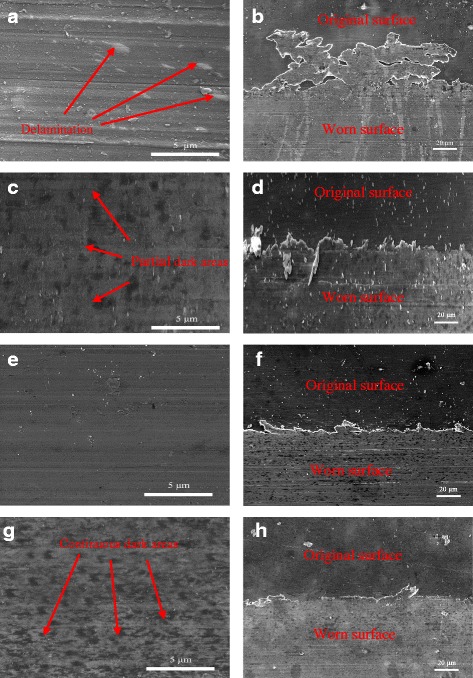
The worn surface morphologies and the edge analysis of the worn surface lubricated with a, b base oil, c, d pure MoS2 nanofluids, e, f pure SiO2 nanofluids, and g, h SiO2/MoS2 (0.25:0.75) hybrid nanofluids (8 N, 30 mm/s, 1.5 h)
The XPS analyses of Mo3d, S2p, O1s, Fe2p, and Si2p on the wear tracks lubricated with pure MoS2 nanofluids or SiO2/MoS2 hybrid nanofluids were further carried out to monitor the chemical changes. As shown in Fig. 8a, c, e, g concerning the rubbed surface lubricated with pure MoS2 nanofluids, Mo3d exists as MoS2 with peaks at 230.6 and 229.2 eV [37]. This may indicate that nano-MoS2 have physical adsorption on the worn surfaces. The additional contribution of Mo3d at higher energy, in association with the O1s peak at 530.5 eV, can be attributed to oxygenated Mo (VI) species. It is reasonable to presume that the adsorbed MoS2 platelets were oxidized partly into oxides of molybdenum during the rubbing process [38]. The XPS peak of the S2p spectrum appears at 163.2 eV, which corresponds to MoS2. Apart from MoS2, the weak S2p peak at higher binding energy (169.5 eV) is ascribed to MgSO4. Even so, the O1s signal assigned to MgSO4 is not observed in Fig. 8e. A possible reason for this phenomenon is that the amount of MgSO4 is not enough to affect the XPS spectra of O1s. Besides, the peak of S2p at 161.9 eV is difficult to be clarified because the binding energy of iron sulfide species (FeS) and molybdenum disulfide (MoS2) is both between 161 and 162 eV [37]. In order to determine the actual type of compound, the XPS of Fe2p was studied as shown in the inset of Fig. 8c. It can be seen that the signal of iron was not detected. Therefore, we argue that the peak of S2p at 161.9 eV comes from MoS2 and not FeS. For the SiO2/MoS2 hybrid nanofluids, the Mo3d spectrum appears at approximately 230.1 and 233.1 eV (Fig. 8b), which correspond to MoS2 (in association with S2p peak at 161.2 eV) and MoO3 (in combination with O1s peak at 530.4 eV), respectively. There are some differences between the samples with respect to the distribution of the oxides of molybdenum. The sample lubricated with the SiO2/MoS2 hybrid nanofluids shows less oxide present compared to the sample lubricated with pure MoS2 nanofluids. It suggests that the introduction of nano-SiO2 prevents the oxidation of the MoS2 on the specimen surface. The S2p spectrum for the SiO2/MoS2 hybrid nanofluids consists of two peaks (Fig. 8d). The peak at 161.2 eV is attributed to MoS2, and the peak located at 169.2 eV is assigned to MgSO4 (in association with the O1s peak at 532.5 eV). Interestingly, it can be seen from the spectra that the wear tracks lubricated with SiO2/MoS2 hybrid nanofluids show a much stronger signal for MgSO4 in contrast to the wear tracks lubricated with pure MoS2 nanofluids. The higher intensity for the SiO2/MoS2 hybrid nanofluids may lie in the fact that MoS2 mixed with SiO2 can easily react with magnesium alloy, indicating that more compact tribo-chemical film is obtained on the worn surface lubricated with the SiO2/MoS2 hybrid nanofluids. The result is also confirmed by the FESEM images in Fig. 7c. The other interesting difference is that Si2p at 103.2 eV (Fig. 8h) ascribed to SiO2 is found on the worn surface lubricated with the SiO2/MoS2 hybrid nanofluids [39], whereas at the same position, there are no clear signal peaks when lubricated by pure MoS2 nanofluids (Fig. 8g). Therefore, it can be concluded that the nano-SiO2 participated in the formation of the lubricating film and collaborated with the nano-MoS2 to lubricate the magnesium alloy surface. These results confirm that the positive effect of the SiO2/MoS2 hybrid nanofluids is more pronounced in terms of the lubrication properties when compared to that found with the pure MoS2 nanofluids.
Fig. 8.
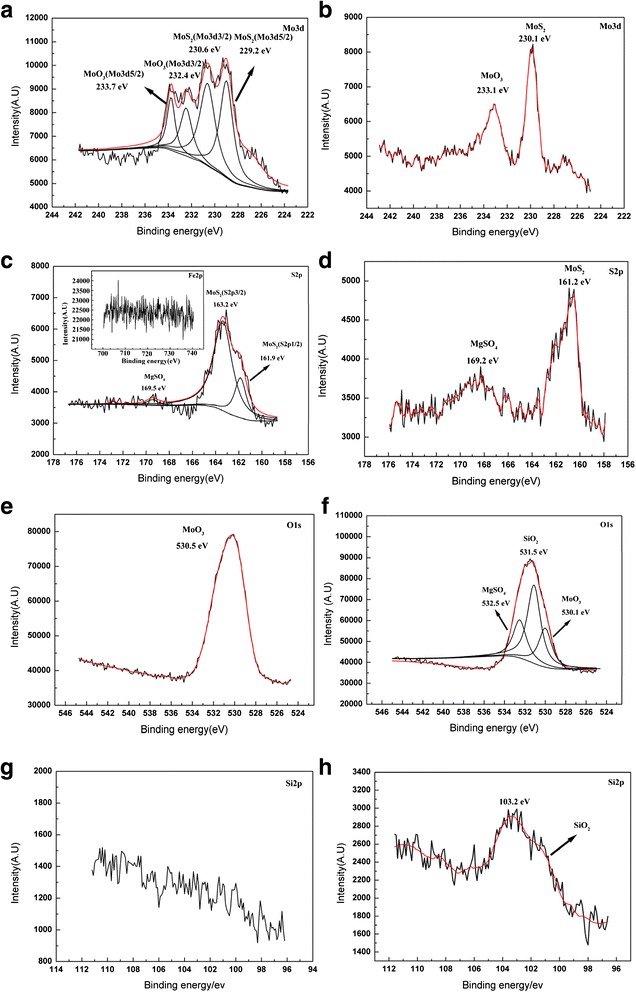
X-ray photoelectron spectra of the elements (Mo3d, S2p, O1s, Fe2p (inset of Fig. 11c), and Si2p) on the worn surface lubricated with pure MoS2 nanofluids (a, c, e, g) and SiO2/MoS2 (0.25:0.75) hybrid nanofluids (b, d, f, h) (8 N, 30 mm/s, 1.5 h)
Lubrication Mechanism of the SiO2/MoS2 Hybrid Nanofluids
According to the friction tests run on a reciprocation ball-on-plate friction tester, it can be found that the SiO2/MoS2 hybrid nanoparticles as lubricant additive exhibit superior lubricating performances than individual nanopartcles. To understand the mechanism that is underlying the trends seen in the lubrication responses, the high magnification FESEM-EDS spectra of the worn surface lubricated with the 1.00 wt% SiO2/MoS2 (0.25:0.75) hybrid nanofluids is chosen for detailed analyses in Fig. 9. The schematic explanation of the corresponding lubricating mechanisms is summarized in Fig. 10. Figure 9 clearly shows that nano-MoS2 protects the surface of magnesium alloy in two ways. At first, nano-MoS2 is physically adsorbed on the contact surface via the flow of lubricating oil and compressive stress. Intrinsically, hexagonal lamella of nano-MoS2 is stacked by weak van der Waals force between layers. Low resistance to shear between the weakly interacted lamella under the sliding contact stress reduced the friction coefficient. Besides that, when a normal force exists, the MoS2 nanoparticle will extend into thin physical films in the contact zone. As the test time goes on, the applied load during sliding will produce high temperature and pressure. The deposited nano-MoS2 on the surfaces will undergo complex tribo-chemical reactions, resulting in forming a new chemical transfer film on the lubricated metal surface. Combined with the XPS spectra (Fig. 8), the tribo-chemical reaction film is composed of MoO3 and MgSO4. The tribo-chemical reaction film strongly combines with the workpiece material, which is essential for efficient long-term lubrication. The mechanism of the tribo-chemical reaction can be directly compared to those obtained in the literature concerning the interactions between MoS2 nanoparticles and steel surface [37]. Figure 11 is drawn to explain the possible binding mechanism of MoS2 on the magnesium alloy surface. Two possible mechanisms were proposed for the interactions between MoS2 nanoparticles and steel surface. The first is associated with a tribo-film adhesion through the bonding of molybdenum with the oxygen that was found in the native surface oxide layer of the steel. Correspondingly, a possible chemical reaction between the molybdenum and the oxygen from MgO is chemically reasonable. This is due to the fact that chemical reaction occurs between MgO and the nano-MoS2 could be explained by a lower bonding energy between Mg and O than between Fe and O on the basis of Pearson hardness (Fig. 11a). Another possibility is that the oxide layer would be removed during the first cycles of the friction test and the reaction between the nano-MoS2 and the Mg metal atoms could occur (Fig. 11b). At this stage, the precise role of the oxide layer in the mechanism of adhesion of the tribo-film on the worn surface is still extremely difficult to judge from the experiments results. Even so, it was shown in this study that a tribo-chemical reaction between the nano-MoS2 platelets could occur via either the native oxide layer or the metal Mg atoms during the frictional process. Besides that, further understanding the role of the protect film at disparate stage of the whole test is crucial and necessary. As shown in Fig. 2, it is apparent that the friction coefficient of pure MoS2 nanofluids is higher during the first 1000 s and then decreases slowly until reaches a steady state. However, this high friction coefficient period was not observable with the pure SiO2 nanofluids and the SiO2/MoS2 hybrid nanofluids. Similar evolution of friction coefficient with time for a steel-steel contact lubricated with pure MoS2 nanofluids, where a higher friction coefficient at the early stage of the test can be seen, was reported by L. Cizaire et al [40]. These authors explain that the friction coefficient is higher at the beginning of the test owing to the absent of the tribo-chemical film. However, the friction coefficient gradually decreased once the tribo-chemical film formed during the rubbing process [41]. In comparison with pure nano-MoS2 additive (Fig. 10a), the SiO2/MoS2 hybrid nanoparticles additive with better catalytic activity may catalyze the oxidation of S2− more quickly during the sliding [42]. So the running-in time required to obtain very low friction values for SiO2/MoS2 hybrid nanoflids is shorter than pure MoS2 nanofluids. Even under static conditions, the chemical reaction does not stop and more and more tribo-chemical compound is generated, leading to the formation of more compact and efficient tribo-chemical film on the worn surface (Fig. 10c).
Fig. 9.
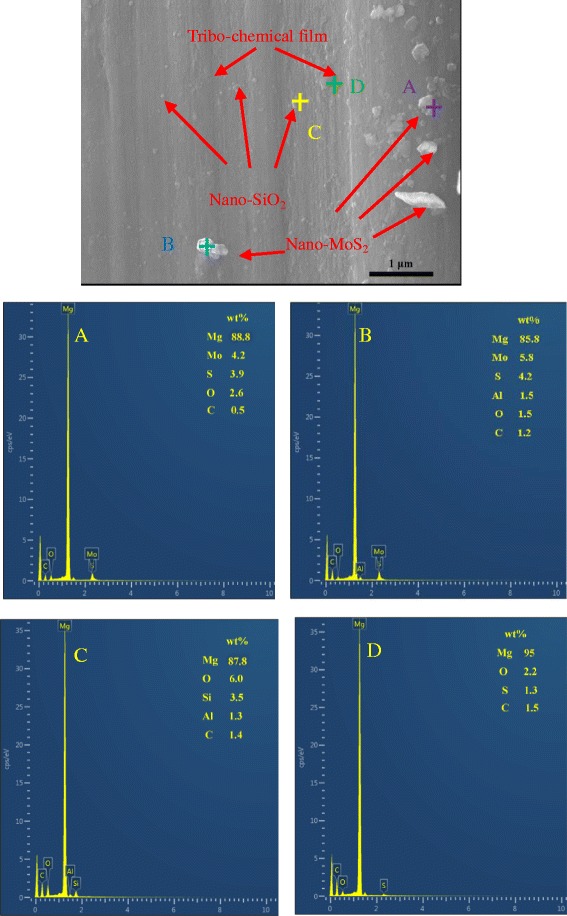
High-magnification FESEM-EDS spectra of worn plate surfaces lubricated with the 1.00 wt% SiO2/MoS2 (0.25:0.75) hybrid nanofluids (8 N, 30 mm/s, 1.5 h)
Fig. 10.
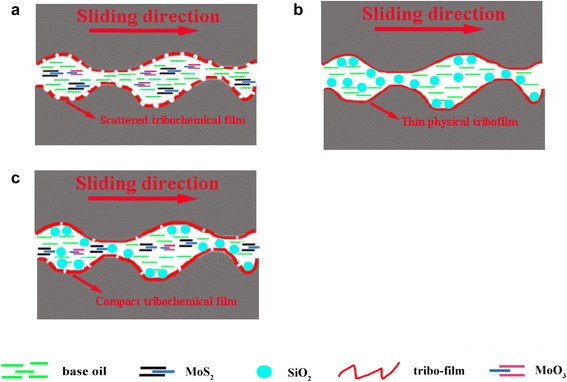
Schematic explanation of the lubricating mechanisms of a pure MoS2 nanofluids, b pure SiO2 nanofluids, and c SiO2/MoS2 hybrid nanofluids
Fig. 11.

Schematic showing the possible binding mechanism of MoS2 on the magnesium alloy surface. a Bonding energy between Mg and O and between Fe and O on the basis of Pearson hardness. b Reaction between the nano-MoS2 and the Mg metal atoms
In contrast, the lubricity mechanism of spherical nano-SiO2 is quite different from that of nano-MoS2 platelets. The higher-magnification image of the worn surface in Fig. 9a and corresponding EDS reveal the presence of nano-SiO2 on the worn surface. Unlike nano-MoS2, nano-SiO2 possesses nano-scale size and excellent dispersion in the base lubricant. These characteristics allow the nano-SiO2 to easily enter the contact area, thereby resulting in faster running-in conditions (Fig. 2). The rolling effect was often proposed as a lubrication mechanism for spherical nanoparticles, although little research has been conducted on the direct visualization of the rolling behavior of the nano-SiO2 into the contact interfaces [33, 43]. In this way, nanoparticles decrease the shear stress and lead to the reduction in friction coefficient. Besides, even though the surface of the magnesium alloy plate was looking smooth, when we observed its micro meter and nanoscale image, the surface was complicated with ridges and valleys. When nanoparticles were added into the base oil, the filling of valleys of the contacting asperities will occur. This is also supported by the high magnification FESEM spectra (Fig. 9), which shows the distribution of nanoparticles on the worn surface. As shown in Fig. 9, it is clearly seen that nano-SiO2 fills up the grooves of the rubbing surfaces, while nano-MoS2 deposits on the flat of the worn surfaces. It demonstrates that the difference in the distribution of nanoparticles on the worn surface is substantial. This can be explained by the model proposed by Mosleh Mohsen [21]. The authors suggested that the nanoparticles can fill up valleys and smooth the surface if the characteristic length l of flaky nanoparticles is smaller than the peak-to-valley roughness of the harder surface which is equal to 4 Ra, i.e., the condition of l < 4 Ra applies. With respect to spherical nanoparticles, the diameter d of the particle should satisfy d < 0.67 Ra. Comparatively, nano-SiO2 with an average size of about 30 nm acts as a third body material filling in the valley of surface with 0.08-μm surface roughness, increasing real contact area. As a result, the load can be distributed over a larger contact area, so that the effective contact pressure decreases and consequently the wear also reduce. However, nano-MoS2 platelets may be difficult to fill in the cavities because its length (more than 300 nm) is larger than 4 Ra in our study. In comparison with pure nano-SiO2 additive (Fig. 10b), the micro-cooperation for SiO2/MoS2 hybrid nanoparticles additive occurred in succession between the shearing-sliding of the nano-MoS2 platelets structure and the filling of nano-SiO2 particles during sliding process, resulting in excellent lubrication performances (Fig. 10c). However, the efficiency of the SiO2/MoS2 hybrid nanofluids was influenced by the mass ratio of SiO2/MoS2. For instance, the lubrication performances of SiO2/MoS2 (0.5:0.5) and SiO2/MoS2 (0.75:0.25) were a little inferior to that of the SiO2/MoS2 (0.25:0.75) at the test condition. Namely, there was an optimum dose of nano-SiO2 in the SiO2/MoS2 hybrid nanofluids. If excess nano-SiO2 was added into the SiO2/MoS2 hybrid nanofluids, the contact area was saturated with nano-SiO2. Any more nano-SiO2 took up the space of nano-MoS2 and disturbed its lubrication. The nano-SiO2 has outstanding mechanical properties especially in terms of hardness (Vickers hardness—1000 kgf/mm2); therefore, the excess hard nano-SiO2 as an abrasive plows the soft magnesium alloy surfaces (Vickers hardness—66.7 kgf/mm2) under the applied load. It will facilitate the abrasion of the magnesium alloy surface during rubbing process and thus results in the worse anti-wear property. This was confirmed by the poor anti-wear behaviors of the samples with high concentrations of nano-SiO2, such as SiO2/MoS2 (0.5:0.5), SiO2/MoS2 (0.75:0.25) and pure nano-SiO2 as shown in Fig. 3a. Therefore, the nano-SiO2 and nano-MoS2 mass ratio of 0.25:0.75 is the best proportion for synergetic lubrication effect under the selected testing conditions. In addition, from the XPS results of the worn magnesium alloy surface, nano-SiO2 is shown to prevent nano-MoS2 from oxidation, resulting in increased oxidation resistance of nano-MoS2 during rubbing process. The oxidation phenomenon may provide an important role in the sense. It could provide a “soft” oxide-like MoO3 which could serve to tether the nanoparticles to the magnesium alloy surface. However, if nano-MoS2 is overmuch oxidized into MoO3, the oxidation destroys the lubrication structure of layered MoS2 and thus results in the worse lubrication property [37]. Therefore, the synergistic lubricating effect enables the SiO2/MoS2 hybrid nanofluids to integrate the advantages and eradicate the disadvantages of SiO2 and MoS2 nanoparticles at optimal ratio. So the SiO2/MoS2 (0.25:0.75) hybrid nanoparticles exhibit superior lubricating performances than individual nano-SiO2 or nano-MoS2 even in high load and diverse velocity cases. Previous work on the combination of MoS2 with other nanoparticles as lubricant additives has reported improvements in their lubricating performance, such as nano-TiO2 [24], carbon nanotubes (CNT) [25], and graphene [26]. Since the testing method and analysis are completely different from the present study, comparable comparison between the results cannot be made. Even so, nano-SiO2 is less costly and facile preparation in contrast with the aforementioned nanoparticles. In conclusion, the SiO2/MoS2 hybrid nanoparticles are suggested as economic and environment friendly lubricant additives for the applications in forming process of magnesium alloy.
Conclusions
In the present study, the tribological properties of the SiO2/MoS2 hybrid nanofluids to be used in metal forming fluids for magnesium alloy were investigated by a reciprocating sliding ball-on-plate contact configuration. Based on the experimental results, the following conclusions were drawn:
Compared with pure nanofluids, the SiO2/MoS2 hybrid nanofluids achieve lower friction coefficient and wear volume even in high load and diverse velocity cases for magnesium alloy/steel contacts under the test conditions.
The optimal SiO2/MoS2 mixing ratio and nanofluids concentration are 0.25:0.75 and 1.00–1.25 wt%, respectively. The 1.00 wt% SiO2/MoS2 (0.25:0.75) hybrid nanoparticles addition into the base oil shows reduction of friction coefficient by 46.6 % and reduction of wear volume by 50.5 % in contrast with the base oil.
The excellent lubrication properties of the SiO2/MoS2 hybrid nanoparticles are ascribed to the physical synergistic lubricating actions of nano-SiO2 and nano-MoS2 during the rubbing process. The synergistic lubricating effect enables the SiO2/MoS2 hybrid nanofluids to integrate the advantages and eliminate the disadvantages of SiO2 and MoS2 nanoparticles at optimal ratio.
Acknowledgements
The authors are grateful for the financial supports from Chongqing Science and Technology Commission (CSTC2013jcyjC60001, CSTC2014jcyjjq0041), National Natural Science Foundation of China (51531002, 51171212,51474043), and The National Science and Technology Program of China (2013DFA71070, 2013CB632200), and Education Commission of Chongqing Municipality (KJZH14101).
Competing Interests
The authors declare that they have no competing interests.
Authors’ Contributions
HMX and BJ carried out the design and drafted the manuscript. BL and QHW prepared samples and carried out tribo-tests. JYX and FSP commented on the results and revised the manuscript. All authors read and approved the final version of the manuscript.
Contributor Information
Hongmei Xie, Email: xhm1983@126.com.
Bin Jiang, Phone: +86 023 65111140, Email: jiangbinrong@cqu.edu.cn.
Bo Liu, Email: 190188519@qq.com.
Qinghang Wang, Email: 281083473@qq.com.
Junyao Xu, Email: 124298482@qq.com.
Fusheng Pan, Email: 1248186052@qq.com.
References
- 1.Md FK, Panigrahi SK. Age hardening, fracture behavior and mechanical properties of QE22 Mg alloy. J Magnes Alloy. 2015;3:210–217. doi: 10.1016/j.jma.2015.08.002. [DOI] [Google Scholar]
- 2.Sunil BR, Ganesh KV, Pavan P, Vadapalli G, Swarnalatha C, Swapna P, Bindukumar P, Pradeep Kumar Reddy G. Effect of aluminum content on machining characteristics of AZ31 and AZ91 magnesium alloys during drilling. J Magnes Alloy. 2016;4:15–21. doi: 10.1016/j.jma.2015.10.003. [DOI] [Google Scholar]
- 3.Griffiths D. Explaining texture weakening and improved formability in magnesium rare earth alloys. Mater Sci Technol. 2015;31:10–24. doi: 10.1179/1743284714Y.0000000632. [DOI] [Google Scholar]
- 4.Selvam B, Marimuthu P, Narayanasamy R, Senthilkumar V, Tun KS, Gupta M. Effect of temperature and strain rate on compressive response of extruded magnesium nano-composite. J Magnes Alloy. 2015;3:224–230. doi: 10.1016/j.jma.2015.07.002. [DOI] [Google Scholar]
- 5.Heinrichs J, Jacobson S. Laboratory test simulation of aluminium cold forming—influence from PVD tool coatings on the tendency to galling. Surf Coat Tech. 2010;204:3606–3613. doi: 10.1016/j.surfcoat.2010.04.025. [DOI] [Google Scholar]
- 6.Njiwa P, Hadj-Aïssa A, Afanasiev P, Geantet C, Bosselet F, Vacher B, Belin M, Le Mogne T, Dassenoy F. Tribological properties of new MoS2 nanoparticles prepared by seed-assisted solution technique. Tribol Lett. 2014;55:473–481. doi: 10.1007/s11249-014-0380-6. [DOI] [Google Scholar]
- 7.Dennis JES, Jin K, John VT, Pesika NS. Carbon microspheres as ball bearings in aqueous-based lubrication. Acs Appl Mater Inter. 2011;3:2215–2218. doi: 10.1021/am200581q. [DOI] [PubMed] [Google Scholar]
- 8.Huang WJ, Du CH, Li ZF, Liu M, Liu WM. Tribological characteristics of magnesium alloy using N-containing compounds as lubricating additives during sliding. Wear. 2006;260:140–148. doi: 10.1016/j.wear.2004.12.039. [DOI] [Google Scholar]
- 9.Huang WJ, Fu Y, Wang J, Li ZF, Liu WM. Effect of chemical structure of borates on the tribological characteristics of magnesium alloy during sliding. Tribol Int. 2005;38:775–780. doi: 10.1016/j.triboint.2004.11.007. [DOI] [Google Scholar]
- 10.Xia YQ, Jia ZF, Jia JH. Advanced Tribology, Springer. 2010. Tribological behavior of AZ91D magnesium alloy against SAE52100 steel under ionic liquid lubricated conditions; pp. 896–898. [Google Scholar]
- 11.Tang ZL, Li SH. A review of recent developments of friction modifiers for liquid lubricants (2007–present) Curr Opin Solid ST M. 2014;18:119–139. doi: 10.1016/j.cossms.2014.02.002. [DOI] [Google Scholar]
- 12.Li ZP, Li XF, Zhang YW, Ren TH, Zhao YD, Zeng XQ, van der Heide E. Tribological study of a highly hydrolytically stable phenylboronic acid ester containing benzothiazolyl in mineral oil. Appl Surf Sci. 2014;308:91–99. doi: 10.1016/j.apsusc.2014.04.116. [DOI] [Google Scholar]
- 13.Somers AE, Khemchandani B, Howlett PC, Sun J, MacFarlane DR, Forsyth M. Ionic liquids as antiwear additives in base oils: influence of structure on miscibility and antiwear performance for steel on aluminum. Acs Appl Mater Inter. 2013;5:11544–11553. doi: 10.1021/am4037614. [DOI] [PubMed] [Google Scholar]
- 14.Fan XQ, Wang LP, Li W, Wan SH. Improving tribological properties of multialkylated cyclopentanes under simulated space environment: two feasible approaches. Acs Appl Mater Inter. 2015;7:14359–14368. doi: 10.1021/acsami.5b03088. [DOI] [PubMed] [Google Scholar]
- 15.Fan XQ, Wang LP. High-performance lubricant additives based on modified graphene oxide by ionic liquids. J Colloid Interf Sci. 2015;452:98–108. doi: 10.1016/j.jcis.2015.04.025. [DOI] [PubMed] [Google Scholar]
- 16.Rahmati B, Sarhan AAD, Sayuti M. Morphology of surface generated by end milling AL6061-T6 using molybdenum disulfide (MoS2) nanolubrication in end milling machining. J Clean Prod. 2014;66:685–691. doi: 10.1016/j.jclepro.2013.10.048. [DOI] [Google Scholar]
- 17.Deorsola FA, Russo N, Blengini GA, Fino D. Synthesis, characterization and environmental assessment of nanosized MoS2 particles for lubricants applications. Chem Eng J. 2012;195–196:1–6. doi: 10.1016/j.cej.2012.04.080. [DOI] [Google Scholar]
- 18.Chen Q, Wang X, Wang ZT, Liu Y, You TZ. Preparation of water-soluble nanographite and its application in water-based cutting fluid. Nanoscale Res Lett. 2013;8:52–60. doi: 10.1186/1556-276X-8-52. [DOI] [PMC free article] [PubMed] [Google Scholar]
- 19.Fan XQ, Wang LP, Li W. In situ fabrication of low-friction sandwich sheets through functionalized graphene crosslinked by ionic liquids. Tribol Lett. 2015;58:1–12. doi: 10.1007/s11249-015-0485-6. [DOI] [Google Scholar]
- 20.Kogovšek J, Remškar M, Mrzel A, Kalin M. Influence of surface roughness and running-in on the lubrication of steel surfaces with oil containing MoS2 nanotubes in all lubrication regimes. Tribol Int. 2013;61:40–47. doi: 10.1016/j.triboint.2012.12.003. [DOI] [Google Scholar]
- 21.Mosleh M, Atnafu ND, Belk JH, Nobles OM. Modification of sheet metal forming fluids with dispersed nanoparticles for improved lubrication. Wear. 2009;267:1220–1225. doi: 10.1016/j.wear.2008.12.074. [DOI] [Google Scholar]
- 22.Kogovšek J, Remškar M, Kalin M. Lubrication of DLC-coated surfaces with MoS2 nanotubes in all lubrication regimes: surface roughness and running-in effects. Wear. 2013;303:361–370. doi: 10.1016/j.wear.2013.03.033. [DOI] [Google Scholar]
- 23.Kalin M, Kogovšek J, Kovač J, Remškar M. The formation of tribofilms of MoS2 nanotubes on steel and DLC-coated surfaces. Tribol Lett. 2014;55:381–391. doi: 10.1007/s11249-014-0366-4. [DOI] [Google Scholar]
- 24.Hu KH, Huang F, Hu XG, Xu YF, Zhou YQ. Synergistic effect of nano-MoS2 and anatase nano-TiO2 on the lubrication properties of MoS2/TiO2 nano-clusters. Tribol Lett. 2011;43:77–87. doi: 10.1007/s11249-011-9789-3. [DOI] [Google Scholar]
- 25.Zhang YB, Li CH, Jia DZ, Zhang DK, Zhang XW. Experimental evaluation of the lubrication performance of MoS2/CNT nanofluid for minimal quantity lubrication in Ni-based alloy grinding. Int J Mach Tool Manu. 2015;99:19–33. doi: 10.1016/j.ijmachtools.2015.09.003. [DOI] [Google Scholar]
- 26.Xu YF, Peng YB, Dearn KD, Zheng XJ, Yao L, Hu XG. Synergistic lubricating behaviors of graphene and MoS2 dispersed in esterified bio-oil for steel/steel contact. Wear. 2015;342–343:297–309. doi: 10.1016/j.wear.2015.09.011. [DOI] [Google Scholar]
- 27.Pujante J, Pelcastre L, Vilaseca M, Casellas D, Prakash B. Investigations into wear and galling mechanism of aluminium alloy-tool steel tribopair at different temperatures. Wear. 2013;308:193–198. doi: 10.1016/j.wear.2013.06.015. [DOI] [Google Scholar]
- 28.Sayuti M, Sarhan AAD, Hamdi M. An investigation of optimum SiO2 nanolubrication parameters in end milling of aerospace Al6061-T6 alloy. Int J Adv Manuf Technol. 2012;67:833–849. doi: 10.1007/s00170-012-4527-z. [DOI] [Google Scholar]
- 29.Xie HM, Jiang B, He JJ, Xia XS, Pan FS. Lubrication performance of MoS2 and SiO2 nanoparticles as lubricant additives in magnesium alloy-steel contacts. Tribol Int. 2016;93:63–70. doi: 10.1016/j.triboint.2015.08.009. [DOI] [Google Scholar]
- 30.Rudenko P, Bandyopadhyay A. Talc as friction reducing additive to lubricating oil. Appl Surf Sci. 2013;276:383–389. doi: 10.1016/j.apsusc.2013.03.102. [DOI] [Google Scholar]
- 31.Singh VK, Elomaa O, Johansson L-S, Hannula S-P, Koskinen J. Lubricating properties of silica/graphene oxide composite powders. Carbon. 2014;79:227–235. doi: 10.1016/j.carbon.2014.07.063. [DOI] [Google Scholar]
- 32.Xu YF, Zheng XJ, Yin YG, Huang J, Hu XG. Comparison and analysis of the influence of test conditions on the tribological properties of emulsified bio-oil. Tribol Lett. 2014;55:543–552. doi: 10.1007/s11249-014-0384-2. [DOI] [Google Scholar]
- 33.Ge X, Xia Y, Cao Z. Tribological properties and insulation effect of nanometer TiO2 and nanometer SiO2 as additives in grease. Tribol Int. 2015;92:454–461. doi: 10.1016/j.triboint.2015.07.031. [DOI] [Google Scholar]
- 34.Rapoport L, Leshchinsky V, Lapsker I, Volovik Y, Nepomnyashchy O, Lvovsky M, Popovitz-Biro R, Feldman Y, Tenne R. Tribological properties of WS2 nanoparticles under mixed lubrication. Wear. 2003;255:785–793. doi: 10.1016/S0043-1648(03)00044-9. [DOI] [Google Scholar]
- 35.Zhang LL, Pu JB, Wang L, Xue QJ. Synergistic effect of hybrid carbon nanotube-graphene oxide as nanoadditive enhancing the frictional properties of ionic liquids in high vacuum. Acs Appl Mater Inter. 2015;7:8592–8600. doi: 10.1021/acsami.5b00598. [DOI] [PubMed] [Google Scholar]
- 36.Nan F, Xu Y, Xu BS, Gao F, Wu YX, Tang XH. Effect of natural attapulgite powders as lubrication additive on the friction and wear performance of a steel tribo-pair. Appl Surf Sci. 2014;307:86–91. doi: 10.1016/j.apsusc.2014.03.170. [DOI] [Google Scholar]
- 37.Tannous J, Dassenoy F, Lahouij I, Le Mogne T, Vacher B, Bruhács A, Tremel W. Understanding the tribochemical mechanisms of IF-MoS2 nanoparticles under boundary lubrication. Tribol Lett. 2011;41:55–64. doi: 10.1007/s11249-010-9678-1. [DOI] [Google Scholar]
- 38.Koroteev VO, Bulusheva LG, Okotrub AV, Yudanov NF, Vyalikh DV. Formation of MoS2 nanoparticles on the surface of reduced graphite oxide. Phys Status Solidi B. 2011;248:2740–2743. doi: 10.1002/pssb.201100123. [DOI] [Google Scholar]
- 39.Li XH, Cao Z, Zhang ZJ, Dang HX. Surface-modification in situ of nano-SiO2 and its structure and tribological properties. Appl Surf Sci. 2006;252:7856–7861. doi: 10.1016/j.apsusc.2005.09.068. [DOI] [Google Scholar]
- 40.Cizaire L, Vacher B, Le Mogne T, Martin JM, Rapoport L, Margolin A, Tenne R. Mechanisms of ultra-low friction by hollow inorganic fullerene-like MoS2 nanoparticles. Surf Coat Tech. 2002;160:282–287. doi: 10.1016/S0257-8972(02)00420-6. [DOI] [Google Scholar]
- 41.Koshy CP, Rajendrakumar PK, Thottackkad MV. Evaluation of the tribological and thermo-physical properties of coconut oil added with MoS2 nanoparticles at elevated temperatures. Wear. 2015;330–331:288–308. doi: 10.1016/j.wear.2014.12.044. [DOI] [Google Scholar]
- 42.Han XH, Wang AJ, Wang XS, Li X, Wang Y, Hu YK. Catalytic performance of P-modified MoO3/SiO2 in oxidative desulfurization by cumene hydroperoxide. Catal Commun. 2013;42:6–9. doi: 10.1016/j.catcom.2013.07.027. [DOI] [Google Scholar]
- 43.Sia SY, Sarhan AAD. Morphology investigation of worn bearing surfaces using SiO2 nanolubrication system. Int J Adv Manuf Technol. 2014;70:1063–1071. doi: 10.1007/s00170-013-5340-z. [DOI] [Google Scholar]


